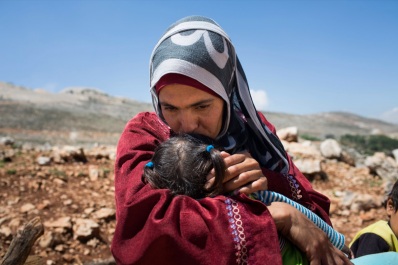By Victor Ordonez

Fordham students experience what it would be like to be a refugee. (Victor Ordonez/The Fordham Ram)
On Monday, the same day that President Donald Trump signed a revised executive order banning citizens from six Muslim-majority nations from traveling to the United States, Campus Ministry hosted a Refugee Simulation located in the McGinley Center.
Assistant to the Vice President of Campus Ministry, Gil Severiano, organized the event to educate students and attendees by providing an in-depth simulation that would place them in the shoes of refugees. Severiano attributed aspects of the simulation to various other programs, including simulations developed by the Jesuit Refugee Service (JRS), Doctors Without Borders and the Kino Borders Initiative.
The project was in honor of basic Catholic teachings, according to Severiano. Specifically, Serveriano said that the simulation was inspired by Pope Francis and his deep concern for the refugee crisis.
“Particularly, the Pope has been very prolific in his teachings and his writings about the plight of refugees and the duty we all have to accept them as our brothers and our sisters,” said Severiano. “They should be considered nothing less than family.”
Pope Francis’ most recent call to action came on Jan. 15, as he said that “every possible measure should be taken” to protect young refugees.
The simulation was divided into four main sections. Students and participants began their journey in their homeland, represented by McGinley 237. Here, all participants had to choose eight items to take with them on their journey as refugees. These items ranged from basic necessities such as food and water to non-essentials represented by cell phones and pets.
In the following section, the simulation required students to board a dinghy traveling from Turkey to Greece, represented by a drawn-to-scale outline on the McGinley Ballroom floor. Witnesses and survivors of the endeavor have said to seen upward of 40 refugees on one dingy. Volunteers worked to depict this image.
Participants also learned that last year alone around 7,000 refugees died trying to make the travel across the Aegean Sea.
Upon disembarking, participants arrived at the gates of the resettlement camp, also located in the McGinley Ballroom. Severiano greeted each participant and gave them new identities with a detailed description of their past and where they were from. They also recieved stamps that would later provide them with water, food, healthcare, shelter and education.
Organizers positioned the healthcare station to be the first participants would encounter after entering the camp. Each Fordham refugee rolled a die that would land on any number of ailments of which they would contract. Immediately after, a coin would be tossed to determine whether or not the camp had the necessary medical resources to aid in that ailment.
The water and shelter station came with their own sets of drawbacks as well. The water station would only supply a gallon of water per person, and the shelter station supplied only one low-rise tent meant to house two families of four to depict refugee living conditions.
The single gallon of water given to refugees in a given day is used for bathing, cooking and drinking. In contrast, the average American uses approximately 17.2 gallons of water when showering.
Finally, the resettlement station is where participants went to end their endeavors as a refugee, or so they thought. Angela Wells, communications officer for the Institute of International Humanitarian Affairs at Fordham University, acted as the chief interrogator of the resettlement station and demonstrated the extreme vetting procedures refugees face. After much questioning, most simulated refugees were denied access to resettle. If the simulation had been real, refugees denied would be forced to remain in the camps.
Of the millions of refugees, approximately 145,500 of them were filed for possible resettlement within various European countries in the year of 2016. The rest were either denied or delayed to further vetting procedures.
John Kuyat, FCRH’19, was a participant denied from settlement. Kuyat found the experience to be educational for both him and other participants alike.
“The things I had to leave behind when entering the boat, the space I had to live in… the simulation brought it all to a deeper, more comprehensive level,” said Kuyat. “The fact that this actually happens to millions of people on a daily basis is unimaginable. It was tough enough going through it as a simulation.
A second Refugee Simulation will be run by Campus Ministry at Fordham’s Lincoln Center Campus Thursday, March 9.
